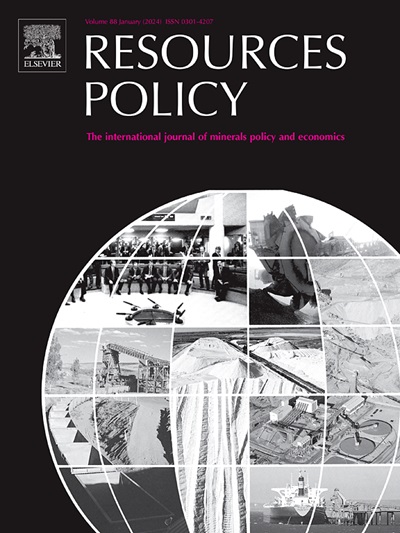评估金矿开采对当地社区的双重影响:社会经济效益和环境挑战
IF 10.2
2区 经济学
0 ENVIRONMENTAL STUDIES
引用次数: 0
摘要
本研究评估了中国白云鄂博当地社区金矿开采对环境和社会经济的影响,在当地,矿业导致的经济增长与相当严重的环境和社会问题并存。这项研究将定量环境评估与定性社会经济分析相结合,以确定金矿开采的双重后果。研究表明,环境严重退化,包括水污染、土壤侵蚀和森林砍伐,当地河流中的砷和氰化物浓度超过了世界卫生组织和美国环保署的安全限值。社会经济评估显示,采矿业极大地增加了家庭收入,占手工采矿者工资的 74%;然而,这些好处的分配并不公平。社区调查显示,人们对矿业公司的做法不满,特别是对企业社会责任的努力不够以及忽视环境和社会影响的做法不满。由于采矿对环境和基础设施造成的后果,约 58% 的受访者对采矿持负面态度。研究强调了对可持续采矿技术、更严格的监管框架和改善社区参与的迫切需要。政策建议包括实施先进的环境评估技术、鼓励替代生计以及公平分配资源,以协调经济增长与环境和社会的可持续性。未来的研究应采用纵向研究和不同采矿地点的比较分析,以调查所建议的补救措施的长期效果和有效性。本研究为政策制定者和利益相关者提供了实用的见解,以减轻金矿开采的负面影响,同时优化其优势。本文章由计算机程序翻译,如有差异,请以英文原文为准。
Assessing the dual impact of gold mining on local communities: Socio-economic benefits and environmental challenges
This research evaluates the environmental and socio-economic effects of gold mining in the local community of Baiyun'ebo in China, where mining-induced economic growth is coupled with considerable environmental and social issues. This research combines quantitative environmental evaluations with qualitative socio-economic analysis to determine the dual consequences of gold mining. Research indicates significant environmental degradation, encompassing water contamination, soil erosion, and deforestation, with arsenic and cyanide concentrations in local rivers surpassing WHO and EPA safety limits. Socio-economic evaluations reveal that mining substantially enhances family incomes, accounting for up to 74 % of wages for artisanal miners; yet, these advantages are inequitably allocated. Community surveys reveal discontent with mining companies' practices, specifically insufficient corporate social responsibility efforts and neglect of environmental and social repercussions. Approximately 58 % of respondents had unfavorable attitudes toward mining owing to its environmental and infrastructural consequences. The research highlights the critical need for sustainable mining techniques, more stringent regulatory frameworks, and improved community involvement. Policy recommendations encompass the implementation of sophisticated environmental assessment techniques, the encouragement of alternative livelihoods, and the equitable allocation of resources to harmonize economic growth with environmental and social sustainability. Future studies should use longitudinal studies and comparative analysis across various mining locations to investigate the long-term effects and effectiveness of suggested remedies. This study offers practical insights for policymakers and stakeholders seeking to alleviate the negative impacts of gold mining while optimizing its advantages.
求助全文
通过发布文献求助,成功后即可免费获取论文全文。
去求助
来源期刊

Resources Policy
ENVIRONMENTAL STUDIES-
CiteScore
13.40
自引率
23.50%
发文量
602
审稿时长
69 days
期刊介绍:
Resources Policy is an international journal focused on the economics and policy aspects of mineral and fossil fuel extraction, production, and utilization. It targets individuals in academia, government, and industry. The journal seeks original research submissions analyzing public policy, economics, social science, geography, and finance in the fields of mining, non-fuel minerals, energy minerals, fossil fuels, and metals. Mineral economics topics covered include mineral market analysis, price analysis, project evaluation, mining and sustainable development, mineral resource rents, resource curse, mineral wealth and corruption, mineral taxation and regulation, strategic minerals and their supply, and the impact of mineral development on local communities and indigenous populations. The journal specifically excludes papers with agriculture, forestry, or fisheries as their primary focus.
 求助内容:
求助内容: 应助结果提醒方式:
应助结果提醒方式:


